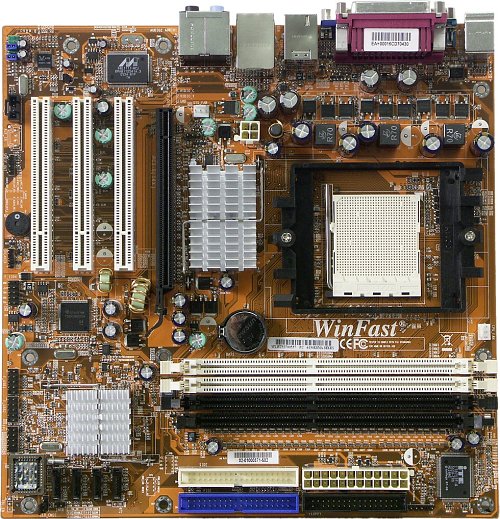 |
||
|
||
| ||
Foxconn was one of the first to respond to launching the new series of NVIDIA chipsets. It expands its wide range of products, whenever the opportunity occurs. It unveiled two models based on modifications of chipset combinations, promising to become very popular: today we are going to review the 6150K8MA-8EKRS motherboard on GeForce 6150/nForce 430; and in the nearest future you can expect P° review of the 6100K8MA-RS on GeForce 6100/nForce 410. The models are practically no different, except for their chipsets (and the resulting functionality), they use the same PCB with the same peculiarities, and even the same BIOS version :). Interestingly, NVIDIA promotes a series of GeForce chipsets as a basis for home theaters, but the 6150K8MA-8EKRS has only a TV-Out on a bracket that hints at this usage. On the whole, motherboard functionality is on a high (for a presumably budget model) level.  The PCB layout is simple (fortunately, there are practically no additional controllers). It's practically excellent for a microATX motherboard. The high heatsink on the northbridge may be an obstacle to install a video card with a bulky heatsink at the back side. As the graphics slot is too close to memory slots, an installed video card may hamper your manipulations with memory modules. The only jumper is placed in an ideal location, access to it is not hampered even when a motherboard is installed into a narrow PC case. There is a brief description of jumper functions on a PCB. Besides, the board also shows the layout of all interface headers, which is a rare thing. The 3-phase switching voltage regulator of the processor incorporates three field-effect transistors per channel, five 3300 uF capacitors, four 1500 uF ones, and several ones of lesser capacitance. The board also contains a voltage regulator for memory consisting of several 1000 uF capacitors. In general, critical circuits incorporate electrolytic capacitors from OST (we are not very enthusiastic about it) and United Chemi-Con. The 6150K8MA-8EKRS is based on a PCB, intended for an entire series of models on NVIDIA GeForce chipsets. But even though this model uses the top chipset in the series, it still has some empty seats on the PCB — BIOS write protection jumper (it's not soldered in all models of the current revision) and an additional audio-in (AUX-In). Motherboard dimensions — 244x244 mm (standard microATX), nine-screw mount, all motherboard edges are firmly fixed. System monitoring (ITE IT8712F-A, according to BIOS Setup)
Onboard ports, sockets, and connectors
Back panel (left to right, blockwise) Click the image to open the rear view of this motherboard
Package Contents
Foxconn SuperUtilites package is a typical set of utilities: SuperStep (to overclock and monitor system parameters), SuperLogo (to change the graphic logo at startup), and SuperUpdate (to search for the latest BIOS version via Internet and to flash the loaded image). Integrated Controllers
The integrated audio quality was tested in 16bit, 44 kHz using the RightMark Audio Analyzer 5.5 test application and the Terratec DMX 6fire sound card:
General performance: Good (Details). It's very strange that HDA support, which finally found its way to NVIDIA chipsets, is not included in this motherboard, which is intended for a home multimedia center! It supports audio output to 8 speakers, but there is no 24-bit audio support and other advantages of High Definition Audio. Considering the penny difference between AC'97 and HDA prices (for example, ALC850/ALC880), the choice of Foxconn engineers seems unexplainable. Proprietary technologies and peculiarities
Settings
We used BIOS dated 16.09.05, the latest available BIOS version at the time of our tests. The mentioned BIOS parameters are available in this version, but the viability of non-standard settings hasn't been tested. There is a load menu function, which allows to choose a boot device to startup a system without modifying BIOS Setup. PerformanceTestbed configurations:
In the nearest future you will be able to read an article devoted to the functionality of NVIDIA GeForce 6000 chipsets. As for now, we offer a traditional express-comparison of results demonstrated by this and other models of the same class. In this case we decided to limit ourselves to publishing the results of a single motherboard on a different chipset (SiS756), as the performance of AMD64 solutions does not depend on a chipset (to be more exact, only periphery's and probably video card's performance depends on it).
On the whole, Foxconn 6150K8MA-8EKRS performance is on a normal level, it demonstrates performance drops only in some gaming modes, which was characteristic of nForce4-based motherboards as well. Though the motherboard under review (with the current BIOS version) does not allow to set DRAM Timing, which is so important for performance, it was automatically set to 1T in our tests; detailed information on the memory mode is displayed at startup. I repeat that such performance and feature analysis of NVIDIA GeForce 6000 chipsets will be soon published in a separate article. Bottom line: this model is very interesting due to its chipset, but Foxconn engineers failed to implement any features to attract users' attention. The deciding factor may be its low price, but we actually had no reliable information about it at the time we published this article. On the whole, this model offers middle-level functionality, middle-level (=normal) performance, and a budget-level bundle. I guess if you are interested in the NVIDIA GeForce 6000 chipset, you can choose a better product, though it may be more expensive.
This model on the manufacturer's web site (Russian mirror) The motherboard is kindly provided by the manufacturer
Write a comment below. No registration needed!
|
Platform · Video · Multimedia · Mobile · Other || About us & Privacy policy · Twitter · Facebook Copyright © Byrds Research & Publishing, Ltd., 1997–2011. All rights reserved. | |||||||||||||||||||||||||||||||||||||||||||||||||||||||||||||||||||||||||||||||||||||||||||||||||||||||||||||||||||||||||